Do your toddlers or preschoolers have some puzzles lying around that they occasionally play with? How often do you make an effort to sit with them and encourage them to build them?
Many people offer them as a way to keep children busy and entertained without fully realizing the importance of puzzles for toddlers’ development. In fact, the simplest play activities for kids are usually the most educational.
Well, it’s time to put aside the fancy toys with flashing lights and music and get those puzzles out if you’d like your children to do some real learning.
Here’s a look at the types of puzzles toddlers should be doing, as well as 11 reasons puzzles are great for toddlers’ development.
Can Toddlers Do Puzzles?
Absolutely, but they need time and freedom to build their skills at their own pace.
They might not be able to do a 48-piece puzzle just yet but they will get there by starting with basic puzzles for toddlers.
During the preschool years, children should be doing them regularly and should be able to complete more difficult puzzles with smaller pieces as they get older.
When Can Toddlers Do Puzzles?
From around the age of 18 months to 2 years, toddlers start showing a greater interest in trying to get basic wooden puzzle pieces into a board, and less interest in eating them!
Each child follows their own unique path in their development, so there is no exact rule as to when they should be able to build them, or what types they will learn to build first.
This depends on what puzzles they have available to them, how often they are encouraged to play with them, and when they develop an interest in them.
Introduce them early on and let your children explore them, feel them and play with them before you expect them to build them.
This post contains affiliate links for educational products that I personally recommend. If you purchase through one of them, I earn a commission at no extra cost to you. Read the terms and conditions for more details.
What Puzzles Should a 2-Year-Old Be Able to Do?
In general, 2-year-olds often start playing with simple peg puzzles, shape sorters, shape puzzles and basic 2 to 4-piece puzzles.
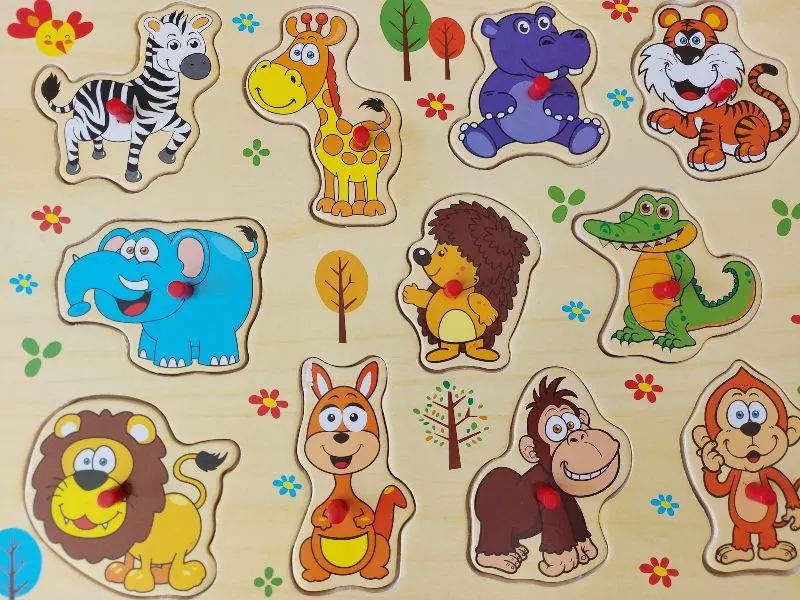
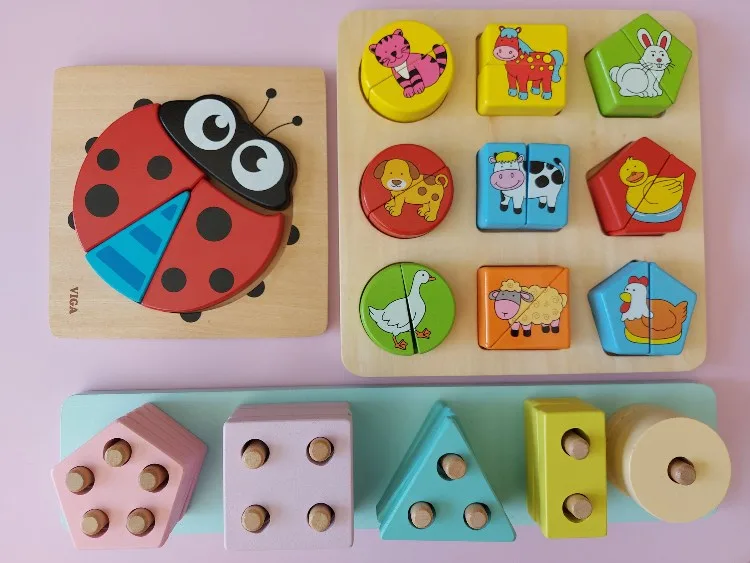
What Puzzles Should a 3-Year-Old Be Able to Do?
At 3 years of age, children will often still be playing with simple shape sorters and peg puzzles but will start transitioning to multiple-piece puzzles, most commonly 9-piece puzzles and 12-piece puzzles.
I have also seen 3-year-olds build puzzles of 24 pieces plus!
How Do You Teach Toddlers to Do Puzzles?
The beauty of play is that children teach themselves skills through trial and error. If your toddlers are exposed to all kinds of puzzles early on they will naturally learn how to do them.
You can show how a piece fits or get them interested by playing with them but rest assured that they will figure something out if they have enough exposure to it.
Starting them early will be the best foundation for being able to build multiple-piece puzzles later on in preschool.
Purchase the types of puzzles outlined in the next section.
You can also supplement with printable puzzles that can be used as cutting activities as well.
The Best Types of Puzzles for Toddlers
There are several different types you can expose your little ones to. Here are a few of them.
They have varying degrees of difficulty and your toddlers will master them at their own pace.
Shape Sorters
This is an example of a shape sorter. It is generally made out of plastic or wood.

Shape sorters like these are excellent for learning to recognize and match shapes, which children must learn to be able to complete jigsaw puzzles:
- CREATIVE SORTING GAME FOR KIDS: The Melissa & Doug Shape-Sorting Cube Classic Wooden Toy is a beautifully...
- CLASSIC LEARNING ACTIVITY: This ever-popular shape and color activity is sure to engage children. Each shape...
Toddlers need to experience things on a concrete level in order to learn. Handling large, three-dimensional shapes is an excellent learning experience, even if your toddler is not yet able to match them accurately.
This is a more advanced shape sorter that is great for developing fine motor control and eye-hand coordination.

Shape Puzzles
Shape puzzles are also three-dimensional shape sorters but the shapes are flatter and they fit into their matching shapes on the board:
- SAFETY GUARANTEE - Toddlers’ safe always come first. SKYFIELD wooden alphabet puzzle for toddlers are...
- ATTRACTIVE COLORS AND SHAPES - 12 different geometric shapes with 12 different bright vibrant colors are...
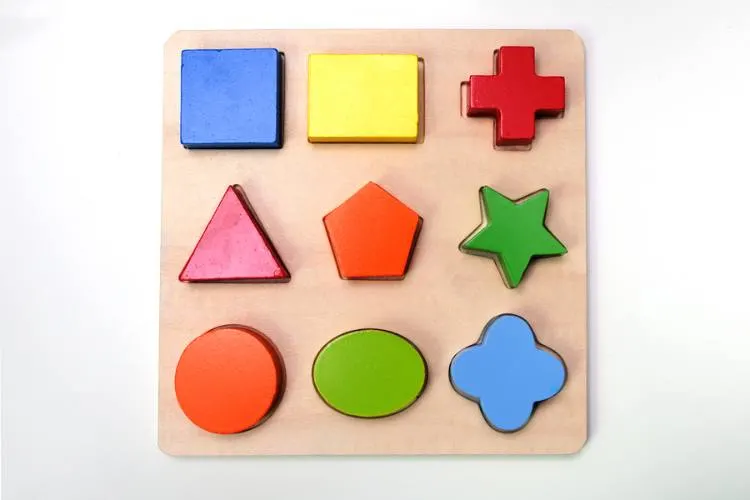
The large foam puzzle mats many toddlers have on the floor in their bedrooms are a similar type.
They usually have letters or numbers inside the squares that can be removed and placed back into their places and they are large enough to provide a good tactile learning experience for toddlers.
Peg Puzzles
Wooden peg puzzles are wooden puzzles with a knob/peg attached to each piece which helps toddlers to handle them with their little fingers.
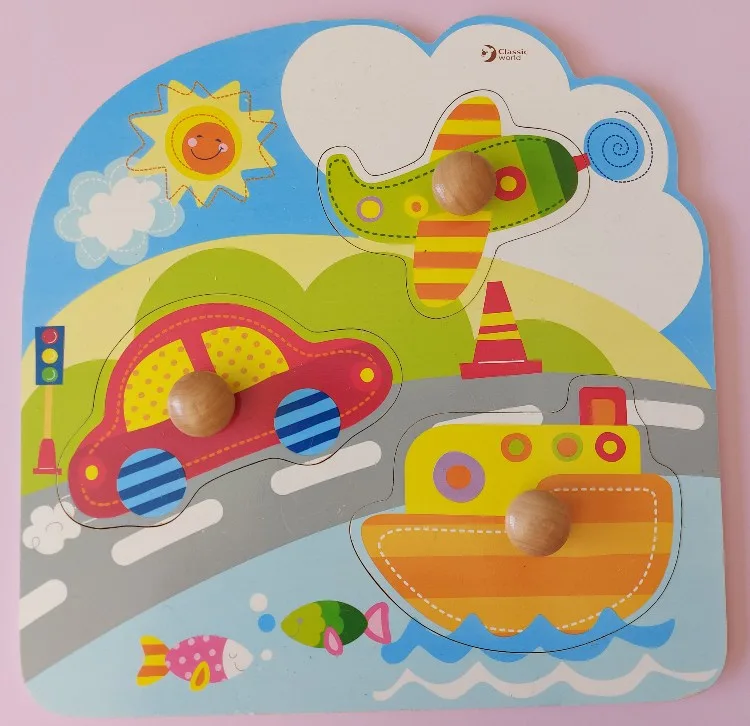
The pieces are flatter (closer to two-dimensional) and the shape of the wooden piece is the outline of the picture.
Whether they are traditional shapes or pictures of animals, they are still developing toddlers’ ability to distinguish the shapes between different objects.

Toddlers have better visual perception than babies and are learning to match abstract shapes. These pieces still fit inside the base board.
This is important because toddlers can learn to fit pieces using both their sense of vision and touch – by looking at the shape and picture, and by feeling if it fits snuggly in its place.
- ONE Melis s a & Dou g Scratch Fun Mini-Pad is bundled with this item. The style of the mini-pad you...
- EASY-TO-GRASP PEG PUZZLE: A vehicle-themed puzzle that features bright colors and illustrations of air, land,...
The more senses children engage the better they learn something.
Jigsaw Puzzles
Jigsaw puzzles are more advanced than basic shape puzzles and require pieces to fit together.
For toddlers, it is best to still have a wooden base that the puzzle fits into, but each piece does not have its own border. The entire picture, made up of multiple pieces, fits into the outline.

Start with puzzles that have few pieces, such as these, and increase the number of pieces as your children gain confidence:
- LEARN THROUGH PLAY: Our delightful set features 6 captivating creatures - Ladybug, Tortoise, Teddy Bear,...
- DESIGNED FOR ENRICHMENT: Crafted specifically for toddlers, these wooden puzzles provide a perfect blend of...
To complete this puzzle below, toddlers must rely more on understanding the visual parts of the picture (e.g. knowing the head of the duck will go at the top).
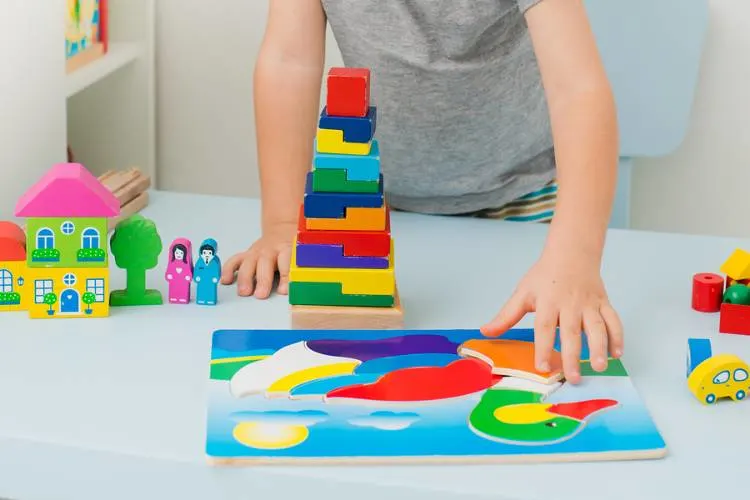
The pieces still fit snuggly next to each other but since each one does not have its own border, there is more room to move them around, until all the pieces fit.
This is often done initially through trial and error until the child learns to spot the pieces more confidently by sight and match them with greater accuracy.
This is a regular jigsaw puzzle that relies on much more advanced visual skills to build. A jigsaw puzzle can have anywhere between 2 and a few thousand pieces (to keep adults entertained!)
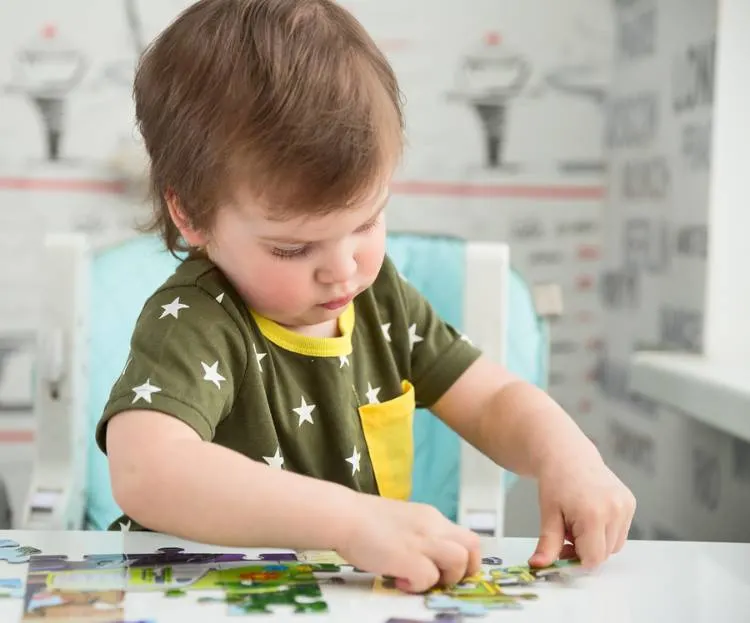
Here are some 9-piece and 12-piece puzzles that are great for toddlers:
- Four wooden jigsaw puzzles: a fish, a dog, a cat, and a bird
- 12-piece puzzles
- 🐻【ADORABLE ANIMAL-THEME PUZZLES】Our toddler puzzle set includes 5 jigsaw puzzles(9 pieces each) with a...
- 🐘【DESIGNED FOR TODDLERS】The color illustration on the bottom is the great reference to babies to...
Puzzles with 2 or just a few pieces can be easier to build than the previous type (with the picture of the duck), so they don’t necessarily move on from one to another but build different types, choosing based on the ones they are able to successfully complete.
As your children get older they will learn to build more intricate puzzles with smaller, more detailed pieces.
To reach the stage of building multiple-piece puzzles, children need a lot of exposure to them. They will not develop this skill with just an occasional puzzle here and there. Try and make them a regular activity in your home.
So, that is roughly how children progress to building puzzles. They don’t necessarily all learn in that exact order and they don’t all have access and exposure to all the different types (I have only listed a few), however, they do follow similar patterns when learning. They progress from:
- Large pieces to small pieces
- Few pieces to many pieces
- Bold, clear images to intricate, detailed images
How do You Know What Type of Puzzle Your Child is Ready For?
As a simple rule, a child should be able to complete a puzzle in a relatively short time, with regular success. They should need to persevere a little but always be able to complete it.
This is how they experience success and develop the motivation to keep doing them and challenge themselves more.
When your children are completing a puzzle really quickly with minimal effort it’s time to expose them to slightly more challenging ones.
The worst thing is to have children become so frustrated with puzzles that they give up and develop an aversion to them.
Here is a list of suitable puzzles for toddlers and puzzles for preschoolers.
So, now that you know how to introduce puzzles and how your children learn to do them, let’s take a brief look at why puzzles are so important for kids’ learning and the many benefits of playing with them.
What Skills Do Puzzles Develop?
What is the role of puzzles in toddlers’ development? Puzzles aid early childhood development in numerous ways.
They have a direct influence on children’s ability to learn to read, write and do mathematics, among other things. They are one of the best kinds of educational toys out there and should be done regularly.
So how exactly does building puzzles help a child’s development? Here’s how…
1. Gross Motor Skills
A child’s first puzzles usually have large pieces and are built on the floor. This means the whole body is engaged when building them and gross motor skills can be developed.
Gross motor refers to the large muscles of the body. Children develop their large muscles before their small muscles (e.g. a baby learns to hold his head up before learning to grasp a toy).
2. Fine Motor Skills
Fine motor refers to the control of the small muscles such as the fingers, toes and eyes. Children must have good fine motor skills in order to be able to hold a pencil and develop the ability to write.
Games and activities that develop gross and fine motor skills are therefore a necessity for learning to write later on.

3. Hand-Eye Coordination
Hand-eye coordination is the ability to perform movements with the hands while being guided by the eyes. A child’s hands and sight work together to perform tasks.
Children need hand-eye coordination to be able to perform everyday tasks, play sports, and read and write. Being able to read and write requires well-developed visual tracking skills.
Building puzzles trains the brain to coordinate the eyes and the movements of the hands.
4. Visual Perception
Visual perception is a necessary skill for learning to read, write and do mathematics. It refers to the brain’s ability to understand and make sense of what the eyes see.
It is not about the eyes being able to see, but rather about correctly processing the information that the eyes see.
A child with poor visual perception could, for example, struggle to see patterns in words when reading, possibly reverse letters when writing or struggle to work with three-dimensional shapes.
Puzzles are one of the best ways to develop visual perception. Children will learn about colour, shape, patterns, depth perception, etc.
5. Language and Concept Development
Puzzles offer an opportunity to build vocabulary and improve language skills. The shapes and images on the pieces represent things and concepts.
These will be reinforced even further if a parent takes the opportunity to extend their child’s vocabulary:
- How many ducks are swimming in the lake?
- You only have two pieces left to fit.
- Where should you put the eyes?
- Let’s find the piece with the other shoe.
6. Problem Solving
All puzzles are basically problems needing to be solved. Each one poses a challenge and requires strategic thought to be completed.
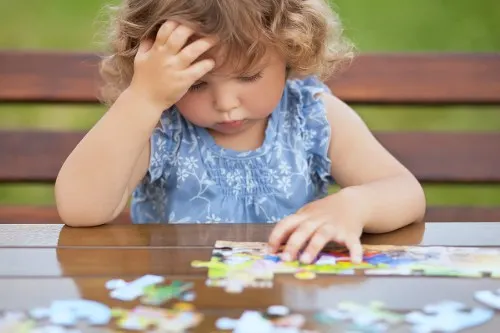
Problem solving is a skill needed throughout school and especially in the workplace and really does begin during the first years of life with simple activities such as building puzzles and becoming used to taking on a challenge.
7. Success and Self-Confidence
It is very important for children to experience success regularly. It is how they build up a feeling of competence and worth. Feeling competent is one of the basic emotional needs of a child.
Puzzles are a great way to experience success since a completed puzzle is a very clear symbol of achievement. It is also a challenging activity so children learn how it feels to put in a lot of effort to achieve that success.
8. Perseverance
The nature of a puzzle is that it must be fully completed to be built, unlike blocks, for example, where you can build anything for any length of time.
Children don’t get a sense of satisfaction when leaving a puzzle incomplete. This is a recipe for developing perseverance as they are often determined to complete the puzzle to feel the satisfaction of having achieved something.
9. Concentration
Building a puzzle is a perfect activity for working on attention span.
As mentioned above, a puzzle must be completed in order for a child to feel he has done it correctly. This means he is likely to stretch himself to work on the task for as long as necessary.
Repeatedly pushing the attention span will lead to overall improved concentration over time.
10. Social Skills
Completing a puzzle with a sibling or friend is a great opportunity to work on social skills.
Children need to cooperate and collaborate as they experience the satisfaction of working towards a common goal.
11. Relieve Tension
Not only do puzzles develop many physical, social and cognitive skills, but they also provide an emotional release. Working on quiet activities is a great stress reliever and a way to relax while learning.
Calm, relaxed children are always in a better space to learn.
(Get your own set of printable puzzles here!)
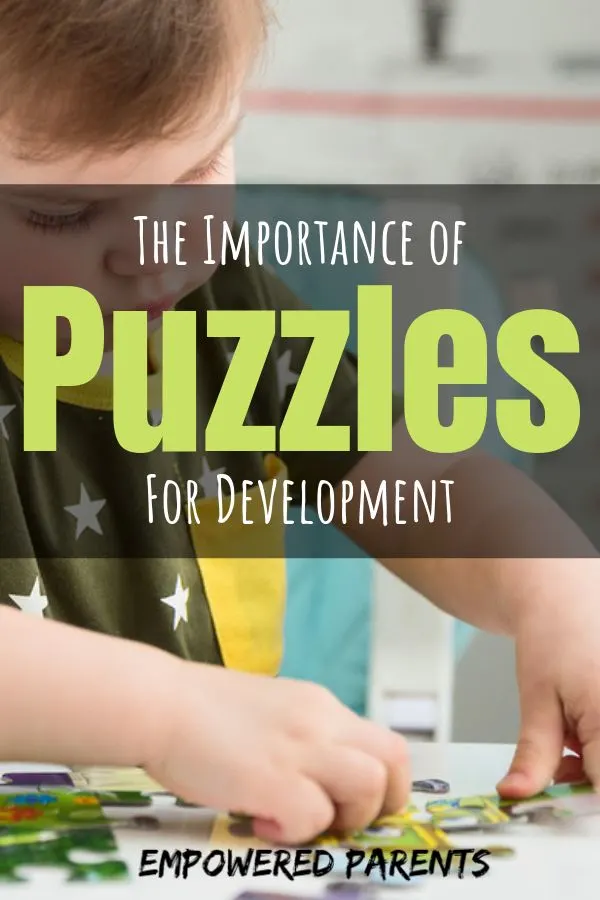







chaya
Tuesday 20th of February 2024
Thank you for your informative article. Where is the puzzle that has small wooden animal photos, each 2 pieces, from?
Tanja McIlroy
Wednesday 21st of February 2024
Thank you. The puzzle belonged to my daughter and was a gift so I don't know where it was from!
Sam
Monday 24th of July 2023
Hello, thanks for your article, I wanted to put my son's puzzle capabilities into perspective. He is 3 yes 3 months and can complete complex puzzles for 5 to 6 year olds 100 to 150 piece with a little support with shape i.e he is learning about starting with the edges and corners. I have to buy a new puzzle each week as once completed the second time he requires no assistance at all. He will do 4 puzzles back to back and wants more.. I can't keep up.. lol
Tanja Mcilroy
Tuesday 25th of July 2023
Wow that is incredible! He must be keeping you on your toes in multiple ways :-) It just shows you how individual children are and how they flourish when encouraged to follow their interests. Amazing.
Anthony
Tuesday 15th of December 2020
Question: A 20 to 22 month old is just developing the ability to do shape sorters and flat puzzle boards, but can’t as yet “see” which pieces go in which spaces, and hasn’t developed the skill to align the piece with the shape. Should the parent help the child to fit the piece correctly or back off and let the child figure it out (or not) by him or herself?
Tanja Mcilroy
Wednesday 16th of December 2020
Hi Anthony, my own toddler is 22 months now so I'm going through the same thing as you with her puzzles and sorters. As their visual perception improves, they will naturally start to match the shapes, but there is no harm in showing them sometimes (as long as you don't feel frustrated or expect them to be able to do it). I usually take the chance to develop her language and vocab by saying "put the monkey in its place" or "where is the big piece" while I show her. Most of the learning will happen naturally!